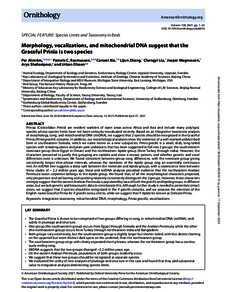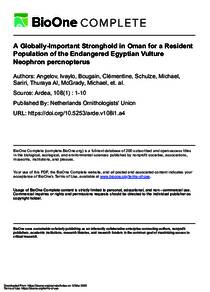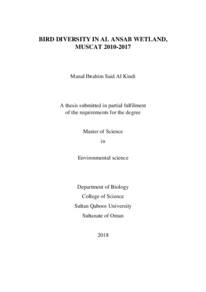Document
Morphology, vocalizations, and mitochondrial DNA suggest that the graceful prinia is two species.
Identifier
DOI: 10.1093/ornithology/ukab014
Source
Ornithology. v. 138, 2
Contributors
Rasmussen, Pamela C., Author
Xia, Canwei., Author
Zhang, Lijun., Author
Liu, Chengyi., Author
Magnusson, Jesper., Author
Shafaeipour, Arya., Author
Olsson, Urban., Author
Country
United Kingdom.
Publisher
Oxford University Press.
Gregorian
2021-04-06
Language
English
English abstract
Prinias (Cisticolidae: Prinia) are resident warblers of open areas across Africa and Asia and include many polytypic species whose species limits have not been seriously reevaluated recently. Based on an integrative taxonomic analysis of morphology, song, and mitochondrial DNA (mtDNA), we suggest that 2 species should be recognized in the Graceful Prinia (Prinia gracilis) complex. In addition, our morphological analyses show the existence of a well-marked undescribed form in southeastern Somalia, which we name herein as a new subspecies. Prinia gracilis is a small, drab, long-tailed species with streaking above and plain pale underparts that has been suggested to fall into 2 groups: the southwestern nominate group (from Egypt to Oman) and the northeastern lepida group (from Turkey through India). However, the characters presented to justify this grouping are variable and show a mosaic pattern, and whether genetic and vocal differences exist is unknown. We found consistent between-group song differences, with the nominate group giving consistently longer inter-phrase intervals, whereas the members of the lepida group sing an essentially continuous reel. An mtDNA tree suggests a deep split between the nominate and lepida groups, with a coalescence time between these clades of ~ 2.2 million years ago. Vocal and mtDNA analyses provided evidence that the northeastern Arabian Peninsula taxon carpenteri belongs to the lepida group. We found that, of all the morphological characters proposed, only proportions and tail barring and spotting relatively consistently distinguish the 2 groups. However, these characters strongly suggest that the eastern Arabian Peninsula is populated by taxa of both the gracilis and lepida groups, in different areas, but we lack genetic and bioacoustic data to corroborate this. Although further study is needed in potential contact zones, we suggest that 2 species should be recognized in the P. gracilis complex, and we propose the retention of the English name Graceful Prinia for P. gracilis sensu stricto, while we suggest that P. lepida be known as Delicate Prinia.
ISSN
0004-8038
Category
Journal articles




